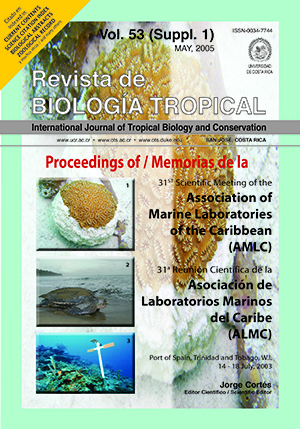Resumen
El pantano Godineau (Oropuche Sur) (3171 ha) en la costa suroeste de Trinidad (10º13-15’N, 61º30-32’W), sufre un impacto fuerte por actividades antropogénicas como pesca, exploración petrolera, drenaje y destrucción del humedal. Para reducir los efectos negativos de las actividades y dar un manejo sostenible, se necesita más información cuantitativa sobre la ecología de este lugar y las actividades que en él se llevan a cabo. Este estudio se enfoca en la distribución de los peces y de las pesquerías, como información base para el manejo. El muestreo fue realizado en el 2002, en abril y mayo (para la época seca) y de julio a septiembre (para la época lluviosa). Se muestreó ictiofauna de día y de noche con redes de trasmallo y redes de empuje (chinchorro). Las actividades pesqueras fueron cuantificadas utilizando un cuestionario y discusiones informales con los pescadores. El humedal mantiene más de 29 especies de peces distribuidas en ambientes de agua dulce, estuarinos y de agua salada (n=1454). La distribución de las especies es estacional, y hay evidencia de que el pantano es utilizado como área de desove. La riqueza de especies y la diversidad (índice de Shannon- Weiner) para el humedal, tienen un ámbito de 2-11 y 0.162-0.967, respectivamente, en la estación seca y de 2-7 y 0.036-0.903, respectivamente, en la estación lluviosa. Hexanematichthys bonillai fue la especie dominante en las comunidades que habitan zonas de agua salada y estuarinas del humedal. Los porcentajes del índice de similitud fueron del 41.8% para agua dulce, 72.7% para estuarios y 79.8% para comunidades estuarinas-saladas. Las especies comerciales comprendieron el 18% de la captura total y constan de: Centropomus undecimalis, Megalops atlanticus, Hoplosternum littorale, Hoplias malabaricus, Ophioscion punctatissimus y Macrodon ancyclodon. Los pescadores de tiempo completo y tiempo parcial, incluyendo los pescadores recreativos, fueron el 14.3% y 85.7% respectivamente, de todos los pescadores encuestados (n=56). Una estimación conservadora de las ganancias por peces y otros mariscos, directamente en el punto de venta, es de aproximadamente US$43 000 por año. La pesca es importante en el área. Se necesitan directrices de manejo que tomen en cuenta la ecología de los organismos clave, para permitir estas prácticas pesqueras de una manera sostenible.Citas
Alleng, G.P. 1997. Coastal wetlands in Trinidad and Tobago: Status and trends research report. Institute of Marine Affairs, Chaguaramas, Trinidad. 59 p.
Anonymous. 1979. Development of the Oropuche area- pre-feasibility study funded by the European Development Fund- Technical report including appendices and maps. SCET Agri International. Portof- Spain, Trinidad. 164 p.
Anonymous. 1999. Fourth progress report on the environmental monitoring program for the 6th sampling period of benthic, marine water and sediment quality and at the construction outfalls at the LNG production plant, Point Fortin, Trinidad. Institute of Marine Affairs (IMA). Document prepared for Atlantic LNG Company of Trinidad and Tobago. 181 p.
Anonymous. 2001. Report on the Investigation of an Oil Spill in the Oropuche River, South Oropuche Swamp, Trinidad. Environmental Incident Report. Institute of Marine Affairs (IMA), Trinidad. 24 p.
Begon, M., J.L. Harper & C.R. Townsend. 1996. Ecology: Individuals, Populations and Communities, 3rd Ed. Blackwell Science, London. 1068 p.
Berkes, F., R. Mahon, P. McConney, R. Pollnac & R.S. Pomeroy. 2001. Managing small-scale fisheries: Alternative directions and methods. International Development Research Centre, Ottowa, Canada. 320 p.
Boodoosingh, M. 1992. A review of possible impacts of human activities on fisheries in the coastal waters of Trinidad, with emphasis on the Gulf of Paria. Fisheries Division, Ministry of Agriculture, Land and Marine Resources, Port-of-Spain, Trinidad. 125 p.
Brower, J.E., J.H. Zar & C.N von Ende. 1990. Field and Laboratory Methods for General Ecology. 3rd Ed. W.C. Brown Publ., Dubuque, Iowa. 237 p.
Clark, J.R. 1992. Integrated management of coastal zone. FAO Fisheries Technical Paper 327. FAO, Rome, Italy. 167 p.
Fischer, W. 1978. FAO species identification sheets for fishery purposes: Western Central Atlantic (Fishing area 31), Vol. II. Food and Agriculture Organization, Rome, Italy.
Itakura, K. 1974. The profile of rice and Oropuche Project. Ministry of Agriculture, Field Engineering, Trinidad and Tobago. 47 p.
James, C. 1990. Wetlands in Trinidad and Tobago. National report for Trinidad and Tobago. 5th Caribbean Foresters’ Conference May 22-25, 1990, Port-of- Spain, Trinidad. 35 p.
James, C., N. Nathai-Gyan & G. Hislop. 1986. Trinidad and Tobago, p. 256-265. In D.A. Scott & M. Carbonell (eds.). A Directory of Neotropical Wetlands: IUCN Concerv. Monitoring Centre, Cambridge, UK.
Kumarsingh K., L.A. Hall & A.M. Siung-Chang. 1996. Spatial and temporal variations of particulate and sediment organic matter on a shallow, tropical, estuarine bank off Trinidad, West Indies. Carib. Mar. Stud. 44: 1-13.
Neilsen, L.A. & D.L. Johnson (eds.). 1983. Fisheries Techniques. South. Print. Comp., Virginia. 468 p.
Rajkumar, G. 2001. A natural resource damage assessment of a contaminated site in the Godineau Swamp, Trinidad. M.Sc. Thesis, Univ. West Indies, Cave Hill, Barbados. 84 p.
Rakocinski, C.F., B.H. Comyns, M.S. Peterson & G.A. Zapfe. 2000. Field growth responses of juvenile white trout (Cynoscion arenarius) to continuous variation in physical habitat conditions. 53rd Ann. Gulf Carib. Fish. Inst., Biloxi, Mississippi. 13 p.
Ramcharan, E.K., G. deSouza & R. French. 1982. Technical report: Inventory of the living resources of coastal wetlands in Trinidad. Institute of Marine Affairs, Chaguaramas, Trinidad. 212 p.
Ramnarine, I.W. 1997. Report on the fisheries ecology of the Caroni swamp. Consultants Report to the Inter American Development Bank, Port-of-Spain, Trinidad. 74 p.
Thurston, R.V. & P.C. Gehrke. 1992. OXYREF (Oxygen Requirements for Fish) a datafile of test results reported in the literature on the respiratory oxygen requirements of fishes. Montana State University, Montana. (Downloaded: October 25, 2004, http://www.epa. gov/ceampubl/swater/oxyref/USERMANU.PDF).
##plugins.facebook.comentarios##

Esta obra está bajo una licencia internacional Creative Commons Atribución 4.0.
Derechos de autor 2005 Revista de Biología Tropical


